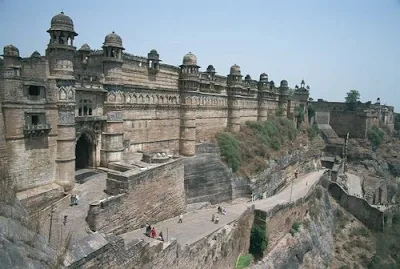Gwalior is the rich musical city of MP (Madhya Pradesh), India.
Gwalior is just 122 kms distant from Agra, whereas Bhopal is situated at 423 km
distance.
Gwalior Fort is world-famous and people are reaching the spot
throughout the year. History behind the fort permits people to study concerning
the several hands controlled the Gwalior fort and the city at different
periods. Tomaras rulers administered the city in 8th century, though Mughal
came in this period and got the Gwalior under their region. In 1754, great
Marathas ruled the city and later Rani Lakshmi Bai; Tatiya Tope and East India
Company ruled the Gwalior city.
Gwalior is famous for educational centers as well like IITM (Indian
Institute of Information Technology and Management), IITTM (Indian Institute of
Travel and Tourism Management), Madhav Institute of Technology and Science
(MITS), Scindia School, and LNIPE (Laxmibai National Institute of Physical
Education). The big five government universities situated in Gwalior are Jiwaji
University, RVSAU (Rajmata Vijyarahe Scindia Agriculture University), MMST
(Maharaja Maan Singh Tomar music and arts university), LNU (Laxmibai National
University of Physical Education) and IIITM. ITM University and Amity are two
private universities of Gwalior city having numerous branches in different
cities of India.
This fourth-largest city of MP is offering countless places for
tourism. Gwalior is a strong cultural heritage with plenty of historical Indian
tourist places. Gwalior is also known for birth of Indian classical music.
Tourist will see the difference by walking the street in the night as many people
of Gwalior start singing and doing practices. This musical city has given many
big singers to Indian musical industry. The big name in Hindustani classical
music singer is Tansen, who was from Gwalior. Vocalist Onkarnath Thakur was
also from Gwalior.
Tourist destinations of Gwalior:
Maharaj Bada: must-visit place of Gwalior having the largest market
of the city. 7 different ancient structures of diverse styles such as Chinese,
Italian, Mughal, Russian, Rajputi, makes the spot different from other markets.
Gopachal Parvat: this is the town hall positioned on the hilly land
Gwalior. It includes exclusive sculptures of Jain Tirthankaras. Here tourist
will also see the world’s largest idol of Lord Parshvanath seated on a lotus.
The height of idol is 47 feet, and the breadth is 30 feet. The sequence of 26
statues of Jain Gurus is also special about this place.
Tomb of Rani Lakshmi Bai: another tourist place for visitors is the
tomb of Rani Lakshmi Bai who was the freedom fighter from Gwalior. This Indian
queen laid her life in 1857 in Gwalior fighting against British Government.
Municipality Museum: next spot for a tourist is a municipality
museum of Gwalior positioned at small distance from the tomb of Rani Lakshmi
Bai.
Sun Temple (Vivsvaan Mandir): recently constructed Sun temple is the
also special place of Gwalior. It is sited near the residency of Morar.
Jai Vilas Palace: This Mahal is turned as a museum of Scandia’s. The
worth seeing antique's sets placed in the museum is special. Here tourist will
see the world’s biggest chandelier.
Gwalior Trade Fair: the biggest fair of India started in 1905 is
conducted in Gwalior. It was begun by Maharaja Madho Rao, one of the rulers of
Gwalior.
Shyam Vatika: other spots to visit in Gwalior is Shyam vatika, which
is the world's largest indoor banquet hall.
Tansen's Tomb: Tansen is having a very important role in Mughal
Empire and his tomb situated in the city is special with the musical kind of
architecture. Tansen was awarded many times for his music, and he was
recognized as the gem of Mughal Ruler Akbar.
Gaus Muhammad's Tomb: other tombs to visit is Gaus Muhammad's tomb.
Gwalior Fort: Gwalior is mainly famous for fort, which is
beautifully constructed by the rulers of Gwalior. Babar expressed this fort as
the pearl of India, which is isolated on rock. Gwalior fort is the largest fort
of India.
Gujari Mahal: the palace constructed in 15th century is another
special monument for visitors. This palace was structured by King Mansingh
Tomar to express his love to Gujar Queen, Mrignayani. Worth seeing the statue
of Shalbhanjika is special in this Mahal. Though, it is open after the special
permission from the museum's curator.
Saas-Bahu Temple: A temple constructed in 9th is placed in Gwalior.
The artistic value of this temple makes is special and tourist from native plus
other states are reaching Gwalior to pray in the temple. Visitors get puzzled by
the name of this temple, which actually means temple of Shashtra Bahu that is
another name of Lord Vishnu.
Teli Ka Mandir: a temple which is also known as Telangana Mandir is
situated in Gwalior. The inimitable structural design of the temple makes it
diverse from other shrines of the city.
Roop Singh Stadium: the international level of cricket ground is
also situated in Gwalior. Approximately, 10 ODI (One-Day International) matches
being conducted in this stadium.
Zoo: those who love watching animals can visit the zoo of Gwalior.
The inimitable collection of animals which include White tiger and many other
wild animals is special for visitors.
Tiger Dam: this dam is situated on the external area of the city.
Tiger dam is the special place for a picnic, and tourist can enjoy the Sank
River's side with some amazing natural views.
Attaining to Gwalior through
Air: Gwalior is having a big international airport, though frequent
domestic flights are available from Delhi and many other cities of India to
reach Gwalior.
Rail: the big rail network of Gwalior connects the city with Delhi,
Jhansi, Agra and many other big cities of the country.


2072007759468.jpg)





















